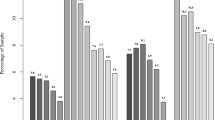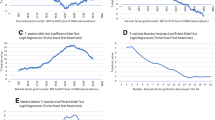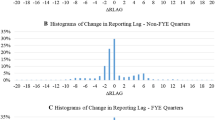Abstract
This article studies the relationship between initial market response to earnings surprise and subsequent stock price movement. We first develop a new measure – the earnings response elasticity (ERE) – to capture initial market response. It is defined as the absolute value of earnings announcement abnormal returns (EAARs) divided by the earnings surprise. The ERE is then examined under various categories contingent on the signs of earnings surprises (+/−/0) and EAARs (+/−). We find that a weaker initial market reaction to earnings surprises, or lower ERE, leads to a larger post-announcement drift. A trading strategy of taking a long position in stocks in the lowest ERE quintile when both earnings surprises and EAARs are positive and a short position when both are negative can generate an average abnormal return of 5.11 per cent per quarter.


Similar content being viewed by others
Notes
1 If no dividend is paid, stock return is the percentage change in price by definition.
2 Some zero earnings surprises are caused by rounding after stock splits. For instance, Stock A’s realized earnings per share is $1 and mean forecast of earnings per share is $0.99. Then the surprise is 1 cent. If Stock A has a 4-for-1 stock split, the realized earnings per share is $0.25 and mean forecast of earnings is $0.2475, which is rounded to $0.25 in the I/B/E/S database. Therefore, the earnings surprise after stock split is $0 because of rounding. We thank researchers at Wharton Research Data Services for kindly pointing this out to us.
3 We build two trading portfolios each quarter by following our ERE strategy and Brandt et al's (2008) EAAR and SUE two-way independent sort strategy, respectively. We then investigate how many stocks are in both portfolios at the same time.
4 This definition is the same as that used by the Wall Street Journal: online.wsj.com/mdc/public/page/2_3024-zurprise.html?mod=mdc_h_earnhl.
5 Many firms in a few trading days and a few firms in many trading days have missing return values, mainly due to missing prices or not trading on the current exchange. We replace the missing values with concurrent benchmark portfolio returns. However, to make EAARs calculation meaningful, we require that the total number of missing days be less than 10 per cent of the number of total trading days. For instance, to calculate 6-month (126 trading days) Drifts, if during this 6-month post-announcement period a firm have more than 13 missing return values, then the 6-month DRIFT of this firm for this quarter is excluded from our sample.
6 Both equal-weighted and value-weighted portfolio returns are calculated for each quintile. The results are similar.
7 We thank an anonymous referee for suggesting this.
8 See Johnson and Zhao (2012) for a detailed discussion.
9 Carhart (1997) reports that for open-end mutual funds from 1996 to 1993, the trading cost is 0.22 per cent for purchases and 0.63 per cent for sales.
If we run a regression of our portfolio's excess returns on the market excess returns alone, the estimated beta is 0.0001. The S&P 500 Index is used as a proxy for the market portfolio in our regressions.
Since all our explanatory variables are standardized, the interpretation of our results is slightly different. For instance, the coefficient on the ERE in Panel A, Table 3 is −0.22, indicating that if ERE increases by 1 SD, the 3-month DRIFT declines by 0.22 per cent.
We thank an anonymous referee for suggesting this.
References
Bartov, E., Radhakrishnan, S. and Krinsky, I. (2000) Investor sophistication and patterns in stock returns after earnings announcements. The Accounting Review 75 (1): 43–63.
Bernard, V. and Thomas, J. (1989) Post-earnings-announcement drift: Delayed price response or risk premium? Journal of Accounting Research 27 (Supplement): 1–36.
Bhojraj, S., Hribar, P. and Picconi, M. (2009) Making sense of cents: An examination of firms that marginally miss or beat analyst forecasts. Journal of Finance 64 (5): 2361–2388.
Bhushan, R. (1994) An informational efficiency perspective on the post-earnings announcement drift. Journal of Accounting and Economics 18 (1): 45–65.
Brandt, M., Kishore, R., Santa-Clara, P. and Venkatachalam, M. (2008) Earnings Announcements are Full of Surprises. Duke University. Working Paper.
Brav, A. and Heaton, J. (2002) Competing theories of financial anomalies. The Review of Financial Studies 15 (2): 575–606.
Burgstahler, D. and Eames, M. (2006) Management of earnings and analysts forecasts to achieve zero and small positive earnings surprises. Journal of Business Finance & Accounting 33 (5–6): 633–652.
Carhart, M. (1997) On persistence in mutual fund performance. Journal of Finance 52 (1): 57–82.
Chan, L., Jegadeesh, C. and Lakonishok, J. (1996) Momentum strategies. Journal of Finance 51 (5): 1681–1713.
Collins, D. and Kothari, S. (1989) An analysis of the cross-sectional and intertemporal determinants of earnings response coefficients. Journal of Accounting and Economics 11 (2–3): 143–181.
Corwin, S. and Coughenour, J. (2008) Limited attention and the allocation of effort in securities trading. Journal of Finance 63 (6): 3031–3067.
Doyle, J., Lundholm, R. and Soliman, M. (2006) The extreme future stock returns following I/B/E/S earnings surprises. Journal of Accounting Research 44 (5): 849–887.
Easton, P. and Zmijewski, M. (1989) Cross-sectional variation in the stock market response to accounting earnings announcements. Journal of Accounting and Economics 11 (2–3): 117–141.
Fama, E. and French, K. (1992) The cross-section of expected stock returns. Journal of Finance 47 (2): 427–465.
Fama, E. and MacBeth, J. (1973) Risk, return, and equilibrium: Empirical tests. Journal of Political Economy 81 (3): 607–636.
Foster, G., Olsen, C. and Shevlin, T. (1984) Earnings releases, anomalies and the behavior of security returns. The Accounting Review 59 (4): 574–603.
Francis, J., LaFond, R., Olsson, P. and Schipper, K. (2007) Information uncertainty and the post-earnings-announcement drift. Journal of Business Finance & Accounting 34 (3–4): 403–433.
Hou, K., Peng, L. and Xiong, W. (2009) A Tale of Two Anomalies: The Implications of Investor Attention for Price and Earnings Momentum. Ohio State University, Working Paper.
Imhoff, E. and Lobo, G. (1992) The effect of ex ante earnings uncertainty on earnings response coefficients. The Accounting Review 67 (2): 427–439.
Jegadeesh, N. and Livnat, J. (2006) Post-earnings-announcement drift: The role of revenue surprises. Financial Analysts Journal 62 (2): 22–34.
Johnson, B. and Zhao, R. (2012) Contrarian share price reactions to earnings surprises. Journal of Accounting Auditing and Finance 27 (2): 236–266.
Kinney, W., Burgstahler, D. and Martin, R. (2002) Earnings surprise materiality as measured by stock returns. Journal of Accounting Research 40 (5): 1297–1329.
Kormendi, R. and Lipe, R. (1987) Earnings innovations, earnings persistence and stock returns. Journal of Business 60 (3): 323–345.
Kothari, S. (2001) Capital markets research in accounting. Journal of Accounting and Economics 31 (1–3): 105–231.
Latané, H. and Jones, C. (1977) Standardized unexpected earnings – A progress report. Journal of Finance 32 (5): 1457–1465.
Liu, J. and Thomas, J. (2000) Stock returns and accounting earnings. Journal of Accounting Research 38 (1): 71–101.
Mendenhall, R. (2004) Arbitrage risk and post-earnings-announcement drift. Journal of Business 77 (4): 875–894.
Mikhail, M., Walther, B. and Willis, R. (2003) The effect of experience on security analyst under-reaction. Journal of Accounting and Economics 35 (1): 101–116.
Ng, J., Rusticus, T. and Verdi, R. (2008) Implications of transaction costs for the post-earnings announcement drift. Journal of Accounting Research 46 (3): 661–696.
Shivakumar, L. (2007) Discussion of information uncertainty and post-earnings-announcement-drift. Journal of Business Finance & Accounting 34 (3–4): 434–438.
Skinner, D. and Sloan, R. (2002) Earnings surprises, growth expectations, and stock returns or don’t let an earnings torpedo sink your portfolio. Review of Accounting 7 (2–3): 289–312.
Teets, W. and Wasley, C. (1996) Estimating earnings response coefficients: Pooled versus firm-specific models. Journal of Accounting and Economics 21 (3): 279–295.
Teoh, S. and Wong, T. (1993) Perceived auditor quality and the earnings response coefficient. The Accounting Review 68 (2): 346–366.
Zhang, F. (2006) Information uncertainty and stock returns. Journal of Finance 61 (1): 105–137.
Zhang, Y. (2008) Analyst responsiveness and the post-earnings-announcement drift. Journal of Accounting and Economic 46 (1): 201–215.
Author information
Authors and Affiliations
Corresponding author
Rights and permissions
About this article
Cite this article
Yan, Z., Zhao, Y., Xu, W. et al. Earnings response elasticity and post-earnings-announcement drift. J Asset Manag 13, 287–305 (2012). https://doi.org/10.1057/jam.2012.8
Received:
Revised:
Published:
Issue Date:
DOI: https://doi.org/10.1057/jam.2012.8




